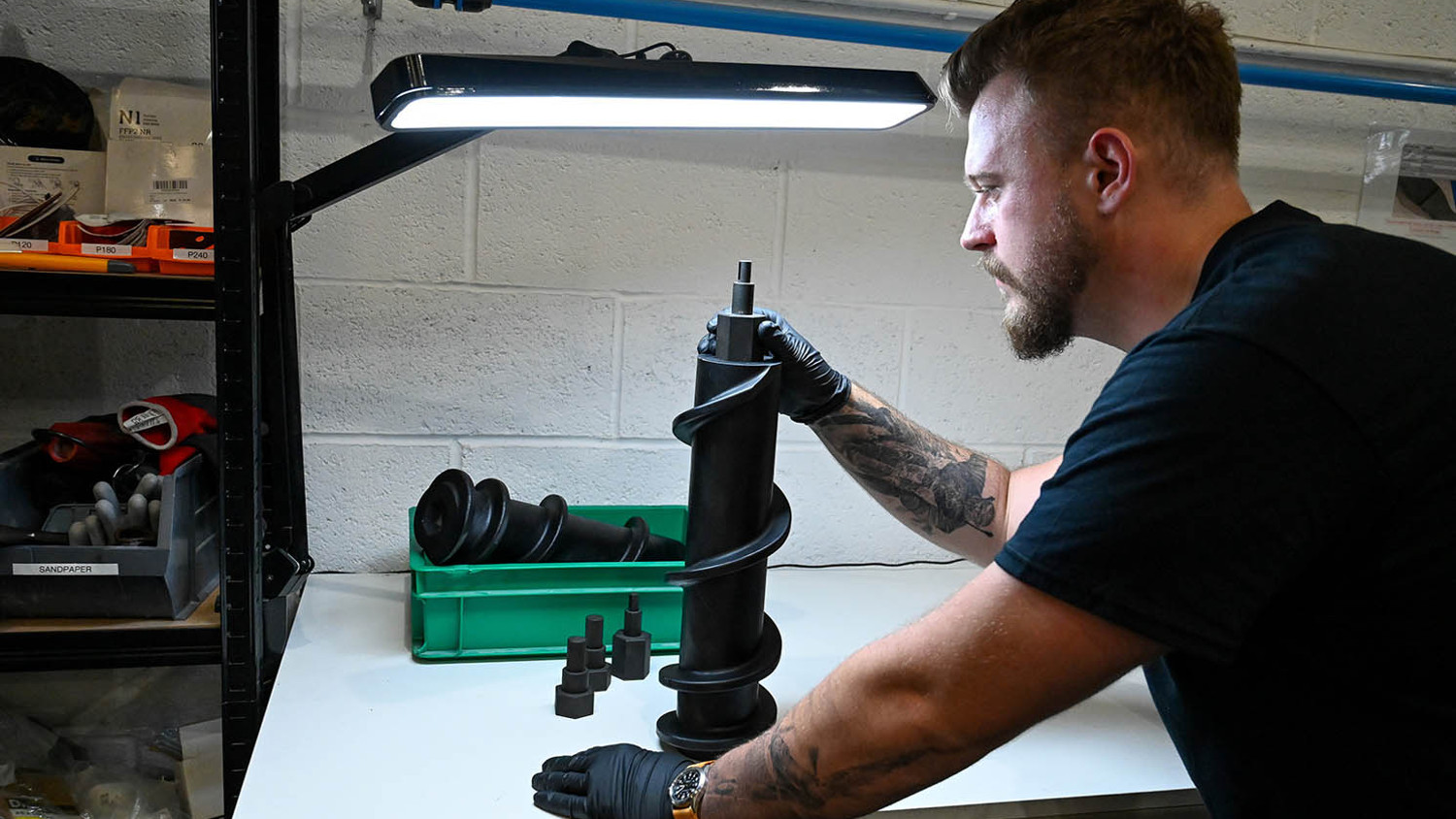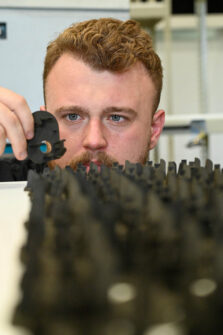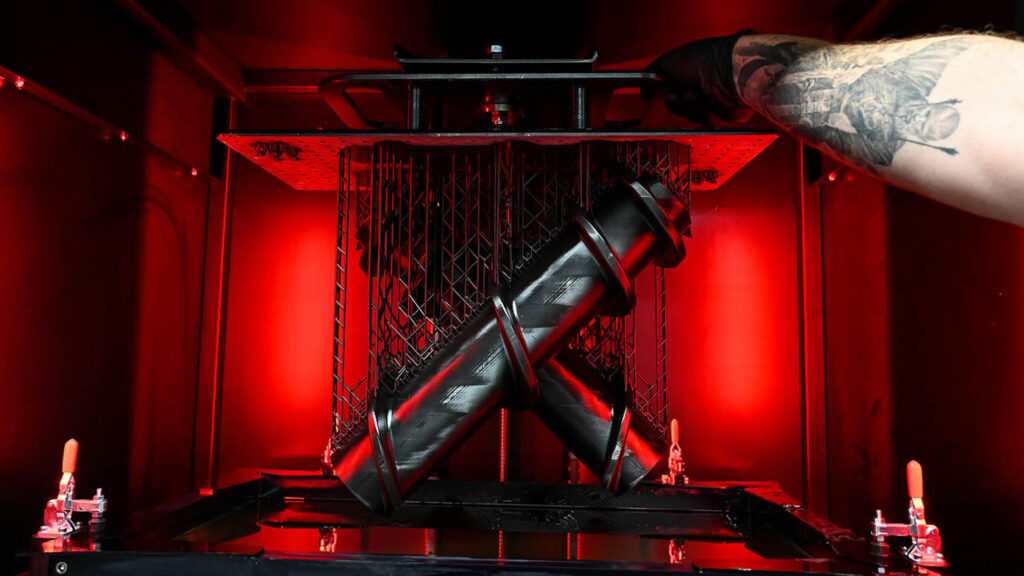Ryse 3D executives can’t disclose much about what the company actually delivers to its automotive customers, but as Stephen Holmes discovers, its highly individual approach to 3D printing is certainly worth talking about
For every brief snippet we can reveal about Ryse 3D, a dozen other details need to be redacted. Based in the unassuming town of Shipston-on-Stour, UK, the production 3D printing service founded in 2017 is ‘officially’ involved in 14 hypercar projects. The term ‘secretive’ doesn’t even begin to cover the hushhush nature of this work.
What we can report is that Ryse 3D works with brands including Aston Martin, Lotus, Williams Advanced Engineering and Gordon Murray Design, along with Tier One OEMs, providing a wide variety of parts for cuttingedge, next-generation vehicles. These range from full HVAC (heating, ventilation and air conditioning) systems to brake ducts and wing mirror vision systems.
Well over £1 million has been invested in the company’s 8,000-square foot facility, with a plan in place to double print output capacity early in 2024, using its own in-house developed 3D printers.
But from there, we need to be careful about what we say. It’s not that Ryse 3D CEO Mitchell Barnes isn’t happy to talk about the company’s work – but he needs to stay mindful at all times that his goal of maintaining Ryse 3D’s position as the go-to 3D printing specialist for automotive heavyweights depends on maintaining excellent relationships based on trust with those companies, not to mention a library of paperwork outlining airtight non-disclosure agreements.
Ryse 3D // A foot in the door
Speaking at a mile-a-minute pace from behind his desk at Ryse 3D’s headquarters, Barnes radiates a deep knowledge of additive manufacturing and a seemingly insatiable passion for the technology.
An enthusiasm for technology, nurtured at a high school fortunate enough to have a D&T workshop featuring 3D printers, led to a work placement at Jaguar Land Rover (JLR), where he was mentored by in-house design team members. Next came a stint studying automotive design at Coventry University. He didn’t enjoy these studies, he says, but his dissatisfaction as a student was alleviated by parttime work at automotive supplier Penso.
Having built a 1 cubic metre FDM 3D printer in his mother’s garage, Barnes soon began taking orders from his fellow students to build their models, too, and paying the professional modelmakers at Penso to finish and paint them. “And then I sold them back to the kids at university for half of what the university was charging,” he laughs.
With his entrepreneurial streak clearly paying off, he was able to start his own production 3D printing company and was careful about choosing the right path.
“3D printing’s a massive space in automotive, but everyone’s got it wrong,” he says. “All the bureaux out there just want to print parts for the sake of printing parts. I could see their model is backwards; they let the machine manufacturers lead the way and just follow along and try and keep up with the market share.”
For Ryse 3D, picking the right projects has always been key, along with keeping a close eye on delivering the production quality expected by automotive clients. Word of mouth quickly spread in the close-knit enclave of UK automotive. Today, the company is recognised and trusted by companies in the sector for its ability to pass the necessary quality and inspection protocols, understand the pressures of the automotive world and speak that world’s language fluently. It is now firmly in the business of making what Barnes refers to as “cool parts for cool cars.”
Ryse 3D // Ticking the right boxes
Along the way, Barnes has developed a sure-fire strategy for delivering what the customer needs when it comes to components.
He reels this off, machine-gun style and barely taking a breath. “You have to massively put yourself in their shoes: What are they trying to achieve? Why? What volume are they looking at? What do they want from a performance perspective? Are there any design challenges that they are facing? Is there a lead time issue? Is there a speed issue? Are there finish requirements that 3D printing can’t handle? Why do they want the part? Is it an A-class surface with a lot of detailed stuff around it?”
Along with getting answers to these questions, he continues, “you have to tick all of the boxes, including the cost-quality-time triangle, and really work together to put that in the right box, rather than just sell capacity. The reason why we use 3D printing to deliver those solutions is because it’s the most flexible technology available.”
A key factor in the success of Ryse 3D, he reckons, is that it strives not to be a faceless online bureau. “We have a proper good relationship with all our customers. And I’d rather have 15 customers that are fantastic that we work with than hundreds or thousands of customers that I don’t know and can’t support on their journey,” he says.
“In my time, I’ve worked in automotive companies where so many amazing, beautiful programmes don’t see the light of day because of cost or development issues, or poor suppliers, or bad management by the customer. We want to be a company that people can trust to work with, and we can develop with them.”

Under the bonnet
At first glance, the hardware that Ryse 3D runs looks similar to that found in most of today’s multifaceted 3D printing bureaux. After all, FDM, DLP, SLA and HP’s MJF make for a pretty commonplace stack of 3D printing technologies.

Barnes and his team, however, have a real knack for pushing the envelope. This is based on his conviction that it’s foolish to just trust ‘the vision’ of 3D printer manufacturers. To make any meaningful progress, he believes, users of these machines need to drive everything themselves.
“The technology is more capable than its makers have realised,” says Barnes. A great deal of Ryse 3D’s success comes down to identifying industry needs and developing workflows and adapting hardware to address those needs. “There’s been a big onus on developing our own machines, modifying machines, pushing machines in terms of software and part development, so that we’re not relying on bloated machine manufacturers to give us solutions that they’re not going to give us,” says Barnes.
“I think we’re different in this space. There’s no one else that makes their own machines, develops the stuff, makes bits and pieces of software, adds volumetric flow smoothing across paths, or adds accelerometers and our own custom electronics into machines, and all sorts of other cool stuff that we do.”
Just as Barnes built that first 3D printer in his mother’s garage, his company now builds its own FDM 3D printers, taking basic machines and then upgrading them with its own hot ends, extrusion parts, gears and fan ducting. This massively pushes printers as far as they can go.
“The small printers that we might build for £2,000 compared to ones we would have to buy for £80,000, we can use to manufacture series production parts for a £2 million car and enable us to scale faster and take on more programmes” he grins. At the heart of his approach is a deep dive into every component the company makes, and a real understanding of what is required, rather than simply trusting the most expensive machine in the workshop to deliver what its vendors say it will.
Earning its keep
As mentioned, the actual work that Ryse delivers isn’t in the public domain, or likely to be any time soon. What we do know is that much of it is focused on short-run exotic models and on pre-production processes for more standard cars. This typically happens when an automotive manufacturer or OEM hasn’t confirmed or validated its own tools, and Ryse 3D will instead step in, either to design and develop a 3D printed tool to make the part, or directly print and validate the part itself.
In one example, a customer facing a lengthy wait for an HVAC ducting system to be delivered already had cars on the assembly line. “So we developed a way of using infrared welding to fuse together parts built using MJF to make them completely solid and create the whole ducting system,” says Barnes.
An entire car ducting system could then be 3D printed in a single printer build, before being assembled. Some 500 sets were built and put together over three months, keeping the assembly line moving and the client extremely pleased.
With an achievement like that under its belt, it’s intriguing to imagine what might be achieved as the worlds of automotive and additive manufacturing continue to move closer together. Barnes undoubtedly has a good idea of what that future looks like – but for now, he’s not saying.
This article first appeared in DEVELOP3D Magazine
DEVELOP3D is a publication dedicated to product design + development, from concept to manufacture and the technologies behind it all.
To receive the physical publication or digital issue free, as well as exclusive news and offers, subscribe to DEVELOP3D Magazine here






